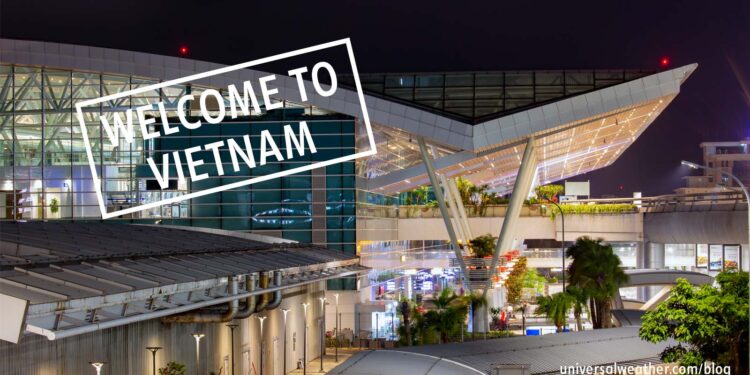Business Aviation in Vietnam: Part 1 – Operational Tips

This is part one of a two-article series on business aircraft operations to Vietnam.
Vietnam is attracting an increasing number of business- and tourism-related General Aviation (GA) movements – primarily to three or four key locations. While GA infrastructure is somewhat restricted in Vietnam, and choices in ground handling services are limited, operations to this part of the world go smoothly for operators who’ve been diligent in the pre-trip planning stage.
The following is an overview of what you need to know when operating in Vietnam:
1. Primary consideration is a reliable ground handling agent
There are not many experienced and reliable GA ground handlers available in Vietnam, and English-speaking skills are often limited in this region. Key consideration for a successful operation to Vietnam is setting up a reliable ground handling agent. When you operate to smaller secondary locations, it’s best to reposition a supervisory handling agent from a larger center. If a chosen ground handler cannot adequately supervise your operations – and ensure that services are provided on a timely basis – there will be issues and potential delays at the airport. Note that fixed-base operators are not available at airports in Vietnam.
2. Popular destinations in Vietnam
Tan Son Nhat Intl (VVTS), Ho Chi Minh City, is by far the most frequent GA destination within Vietnam, and this is followed by movements to the capital city of Ha Noi (VVNB), the business/tourism destination of Danang (VVDN), and popular beach destinations of Cam Ranh (VVCR) and Hue (VVPB). All of these are Airports of Entry (AOEs).
3. Secondary/domestic airports in Vietnam may be restrictive
While most GA operations to and within Vietnam go to the four major airports, there are no restrictions or issues impacting domestic flight operations within the country. Certain local airports and military airfields may be restricted by operating approvals depending on the purpose of your travel. Some secondary airports in Vietnam only have charts available in Vietnamese. In such cases your ground handler may be able to “translate” the charts for you, but it’s the responsibility of the crew to determine whether or not to use these translated charts. Note that landing permits for domestic legs take longer than for AOE permits. For operations to secondary airports in Vietnam, it’s always best to arrange for a supervisory ground handling agent to go out ahead of your arrival. Be advised that operators are responsible for all associated costs for repositioning a handling agent.
4. No airport slots or PPRs are required for Vietnam
No airports in Vietnam currently require airport slots or Prior Permission Required (PPR). Noise regulations are not in effect and at this time it’s still possible to operate Stage 2 aircraft to and within Vietnam.
5. Be aware of new ADS-B requirements
ADS-B requirements for Vietnam were implemented Dec. 12, 2013. Aircraft not meeting these requirements will be restricted to a flight level of 290 or below. Note that this covers eight oceanic air traffic services routes, including L625, M771, N892, L642, M765, M768, N500, and L628, and exemptions are not possible. Effective Jun. 1, 2003, all commercial operations, including charter (non-scheduled commercial), with maximum certified seating of more than 30 seats, or with a maximum takeoff weight greater than 33,069 pounds (15,000 kilograms), must be fitted with ACAS II or TCAS II (version 7.0) to enter Vietnam’s airspace.
6. Consider permit lead times
Permits are processed by the Civil Aviation Administration Vietnam (CAAV). In general, it takes about four business days to obtain a landing or overflight permit for Vietnam. Short-notice requests are possible and usually achievable with one business day’s advance notice for landing permits and a few hours for overflight permits, but it’s at the discretion of the CAAV. While CAAV officially shuts down on weekends/holidays, there’s usually someone available to process permits and permit revisions. For landing permit requests, you’ll need to provide the schedule, operator information, certificates of registration and airworthiness, worldwide insurance (with war risk coverage), crew and passenger information, purpose of trip, and a local business contact, as well as information on your max flight level and operational flight level. Plan on a couple of days’ additional lead time when applying for landing permits for domestic non-AOEs. The reason for this is that the slot officer will need to work with the local airport authority regarding aircraft parking and other local operating requirements. However, for short-notice requests it’s sometimes possible to process domestic permits within one day.
7. Know permit validity
Vietnam permits are valid for +72 hours. Note that if you wish to arrive earlier than the approved permit time, a permit revision will be required. Revisions are needed for changes to schedule (outside the validity window), crew/passenger information, and aircraft registry. Permit revisions in Vietnam generally require 24-48 hours’ notice.
Conclusion
Vietnam is a less-developed GA environment than some of the surrounding countries in terms of services and infrastructure. Operators should allow plenty of lead time in arranging permits and be especially careful in choosing capable ground handlers.
Questions?
If you have any questions about this article or about operating to Vietnam, contact Alan Pong at alanpong@univ-wea.com.
Later, we’ll discuss customs, immigration, and documentation requirements for operating to Vietnam.




